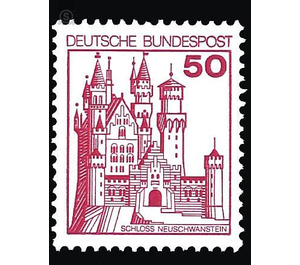Postage stamp: castles and palaces - Germany / Federal Republic of Germany 1977 - 50 Pfennig
Theme: Architecture
| Country | Germany / Federal Republic of Germany |
| Issue Date | 1977 |
| Face Value | 50.00 |
| Color | red |
| Perforation | K 14 |
| Printing Type | Lithography |
| Stamp Type | Postage stamp |
| Item Type | Stamp |
| Chronological Issue Number | 805 |
| Chronological Chapter | GER-BRD |
| SID | 26361 |
| In 91 Wishlists | |
A new series of permanent rolling press with depictions of German castles and palaces replaces the roller-type brand series "Accident Prevention". The postage stamps for 50 and 70 Pfennig appearing as the last two values of this series with the inscription Deutsche Bundespost come out at the same time and in the same motif as the inscription Deutsche Bundespost Berlin. The castle near Füssen in the Allgäu mountains towers high above the Alpsee, dominated by magnificent mountains. It is a magnificent new castle building of King Ludwig II of Bavaria. Once stood here castle Vorderhohenschwangau. Lords of Schwangau are already mentioned in the 12th century, the castle 1428th In the 19th century it was a ruin. In 1868, Ludwig II wrote to his friend Richard Wagner: "My intention is to rebuild the old castle ruin ... in the real style of the old German knight castles. The point is one of the most beautiful to be found, holy and aloof, a worthy temple for the divine friend. «In 1869, the foundation was laid. At the death of Ludwig (1886), the New Castle Hohenschwangau was still unfinished. It was completed in 1892 in a simplified form. The name "Neuschwanstein" did not come into being until 1890. The plans for the monumental building in the late Romanesque style of the early 13th century were created by the theater painter Christian Jank. The journey of Ludwig II to the Wartburg (1867), which he had undertaken at the suggestion of Wagner in preparation for a new production of the opera »Tannhäuser«, provided inspiration. Stage settings also influenced the design. The king checked all the details of the plans and frequently made corrections. The paintings depict themes from Wagner's operas. The architectural sculpture was created by Philipp Perron. In 1884 Ludwig moved the castle for the first time; Here his dream became reality. Neuschwanstein is in many ways a unique monument to one of the major builders of the House of Wittelsbach and a major work of historicism, which significantly promoted the Munich arts and crafts. It shows the unmistakable independent achievements of 19th century art (Michael Petzet). The proud castle, with its bold architecture and sumptuously appointed interiors, is a fairy tale fantasy that has become a magnet for tourists from all over the world. (Text: excerpts from the texts of the German Castle Association e.V. Braubach - Dr. W. Avenarius)


